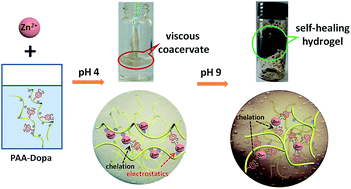Zinc induced polyelectrolyte coacervate bioadhesive and its transition to a self-healing hydrogel†
Abstract
To mimic the underwater adhesion of marine mussels, a bioadhesive has been prepared with a poly(acrylic acid) backbone functionalized with 30% catechol appendants. The polyelectrolyte chains can be reversibly crosslinked through metal chelation and irreversibly gelled by oxidative crosslinking. Surprisingly, the reported “poor” metal chelator Zn2+ not only imparts this injectable adhesive with superior adhesion after the formation of coacervation compared to the one chelated by a stronger metal crosslinker (e.g. Fe3+), but also generates good mechanical performance of the self-healing hydrogel after the oxidation of catechol groups with a pH trigger. Such a pH-responsive material with strong adhesion and good self-healing property at different conditions could be an ideal candidate in biomedical adhesion and tissue engineering.


 Please wait while we load your content...
Please wait while we load your content...